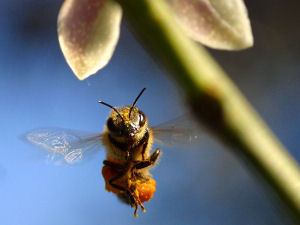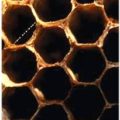
An analysis by Penn State researchers of beehive wax has shown unprecedented levels of fluvalinate and coumaphos – pesticides used in the hives to combat varroa mites – in all hive samples. The researchers also found lower levels of 70 other pesticides (used to protect agricultural crops) and metabolites of those pesticides in pollen and bees.
“Everyone figured that the acaricides (anti-varroa mite chemicals) would be present in the wax because the wax is reprocessed to form the structure of the hives. It was a bit of a shock to see the levels and the widespread presence of these [other] pesticides,” Penn’s Maryann Frazier told the 236th American Chemical Society meeting.
While contaminated wax can be treated using irradiation, reducing the bees’ exposure to external pesticides is far more difficult. Perhaps most worryingly, with the large number of pesticides found in bees and pollen, interactions are likely. “We are finding fungicides that function by inhibiting the steroid metabolism in the fungal diseases they target, but these chemicals also affect similar enzymes in other organisms,” says Frazier. “These fungicides, in combination with pyrethroids and/or neonicotinoids can sometimes have a synergistic effect 100s of times more toxic than any of the pesticides individually.”
Frazier also notes that it is difficult to observe bees outside the hive. The U.S. EPA only looks at acute exposure to individual pesticides, but chronic exposure may cause behavioral changes that are unmonitored. The researchers now want to look at small versus large beekeeping operations and organic versus nonorganic operations to see what, if any, are the differences in exposure.
Related:
Bee Boffins Abuzz With Theories About Honeybee Decline
Cell Phones To Blame For Deserted Bee Colonies?
Two Bees? Aw, Not Two Bees…
Crisis In Bee Population Threatens US Crops








Comments are closed.